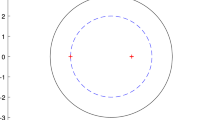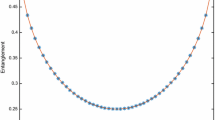Abstract
In our paper, we concentrate on the Z-eigenvalue inclusion theorem and its application in the geometric measure of entanglement of multipartite pure states. We present a new Z-eigenvalue inclusion theorem by virtue of the division and classification of tensor elements, and tighter bounds of Z-spectral radius of weakly symmetric nonnegative tensors are obtained. As applications, we present some theoretical upper and lower bounds of entanglement for symmetric pure state with nonnegative amplitudes for two kinds of geometric measures with different definitions, respectively.
Similar content being viewed by others
References
Chang K, Pearson K, Zhang T (2013) Some variational principles for \(Z\)-eigenvalues of nonnegative tensors. Linear Algebra Appl 438(11):4166–4182
Che M, Qi L, Wei Y, Zhang G (2018) Geometric measures of entanglement in multipartite pure states via complex-valued neural networks. Neurocomputing 313:25–38
Chen L, Han L, Zhou L (2016) Computing tensor eigenvalues via homotopy methods. SIAM J Matrix Anal Appl 37(1):290–319
Chen L, Han L, Yin H et al (2019) A homotopy method for computing the largest eigenvalue of an irreducible nonnegative tensor. J Comput Appl Math 355(1):174–181
Cui C-F, Dai Y-H, Nie J (2014) All real eigenvalues of symmetric tensors. SIAM J Matrix Anal Appl 35(4):1582–1601
Derksen H, Makam V Highly entangled tensors. arXiv:1803.09788v2
Ding W, Wei Y (2015) Generalized tensor eigenvalue problems. SIAM J Matrix Anal Appl 36(3):1073–1099
Friedland S, Kemp T (2018) Most boson quantum states are almost maximally entangled. Proc Am Math Soc 146:5035–5049
Gross D, Flammia ST, Eisert J (2009) Most quantum states are too entangled to be useful as computational resources. Phys Rev Lett 102:190501
Hayashi M, Markham D, Murao M et al (2009) The geometric measure of entanglement for a symmetric pure state with non-negative amplitudes. J Math Phys 50(12):122104
Hbener R, Kleinmann M, Wei T-C et al (2009) Geometric measure of entanglement for symmetric states. Phys Rev A 80(3):032324
He J, Li C, Wei Y (2020) Pseudospectra localization sets of tensors with applications. J Comput Appl Math 369:112580
Hilling JJ, Sudbery A (2010) The geometric measure of multipartite entanglement and the singular values of a hypermatrix. J Math Phys 51:072102
Hu S, Qi L, Zhang G (2016) Computing the geometric measure of entanglement of multipartite pure states by means of non-negative tensors. Phys Rev A 93(1):012304
Kolda TG, Mayo JR (2011) Shifted power method for computing tensor eigenpairs. SIAM J Matrix Anal Appl 32(4):1095–1124
Kolda TG, Mayo JR (2014) An adaptive shifted power method for computing generalized tensor eigenpairs. SIAM J Matrix Anal Appl 35(4):1563–1581
Li C, Li Y (2016) An eigenvalue localization set for tensors with applications to determine the positive (semi-)definiteness of tensors. Linear Multilinear A 64(4):587–601
Li C, Liu Q, Wei Y (2019) Pseudospectra localizations for generalized tensor eigenvalues to seek more positive definite tensors. Comput Appl Math 38:183
Lim L (2005) Singular values and eigenvalues of tensors: a variational approach, In: CAMSAP05: Pro-ceeding of the IEEE international workshop on computational advances in multi-sensoradaptive processing, pp 129–132
Ors R, Dusuel S, Vidal J (2008) Equivalence of critical scaling laws for many-body entanglement in the lipkin-meshkov-glick model. Phys Rev Lett 101:025701
Qi L (2005) Eigenvalues of a real supersymmetric tensor. J Symbol Comput 40:1302–1324
Qi L (2006) Rank and eigenvalues of a supersymmetric tensor, the multivariate homogeneous polynomial and the algebraic hypersurface it defines. J Symbol Comput 41(12):1309–1327
Qi L, Chen H, Chen Y (2018) Tensor Eigenvalues and their applications. Springer, Singapore
Qi L, Zhang G, Ni G (2018) How entangled can a multi-party system possibly be? Phys Lett A 382(22):1465–1471
Teng P (2017) Accurate calculation of the geometric measure of entanglement for multipartite quantum states. Quant Inf Process 16:181
Wang G, Zhou G, Caccetta L (2017) \(Z\)-eigenvalue inclusion theorems for tensors. Discrete Contin Dyn Syst Ser B 22(1):187–198
Wei Y, Ding W (2016) Theory and computation of tensors. Elsevier, Oxford
Wei T-C, Goldbart PM (2003) Geometric measure of entanglement and applications to bipartite and multipartite quantum states. Phys Rev A 68:042307
Wei T-C, Severini S (2010) Matrix permanent and quantum entanglement of permutation invariant states. J Math Phys 51(9):092203
Xiong L, Liu J (2020) A new C-eigenvalue localisation set for piezoelectric-type tensors. E Asian J Appl Math 10(1):123–134
Zhou L, Liu J, Zhu L (2017) The closure property of H-tensors under the hadamard product. J Inequal Appl 231:1–15
Acknowledgements
The authors are grateful to the anonymous referees for their helpful suggestions and comments. This work was supported by the National Natural Science Foundation of China (Grant nos. 11971413 and 11571292).
Author information
Authors and Affiliations
Corresponding author
Additional information
Communicated by Jinyun Yuan.
Publisher's Note
Springer Nature remains neutral with regard to jurisdictional claims in published maps and institutional affiliations.
Rights and permissions
About this article
Cite this article
Xiong, L., Liu, J. Z-eigenvalue inclusion theorem of tensors and the geometric measure of entanglement of multipartite pure states. Comp. Appl. Math. 39, 135 (2020). https://doi.org/10.1007/s40314-020-01166-y
Received:
Revised:
Accepted:
Published:
DOI: https://doi.org/10.1007/s40314-020-01166-y




